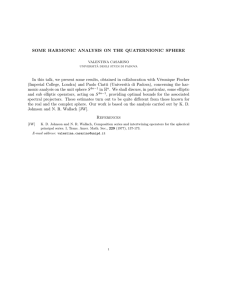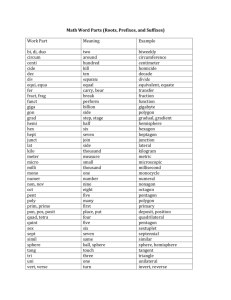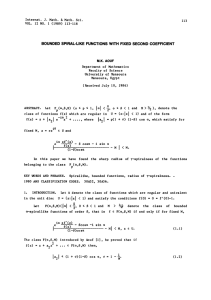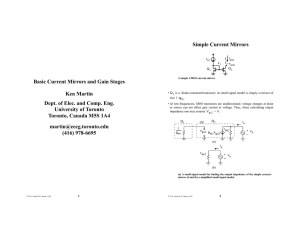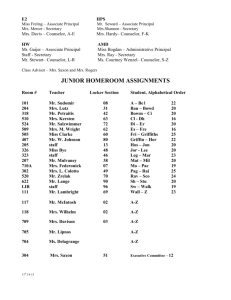Document 10980588
advertisement
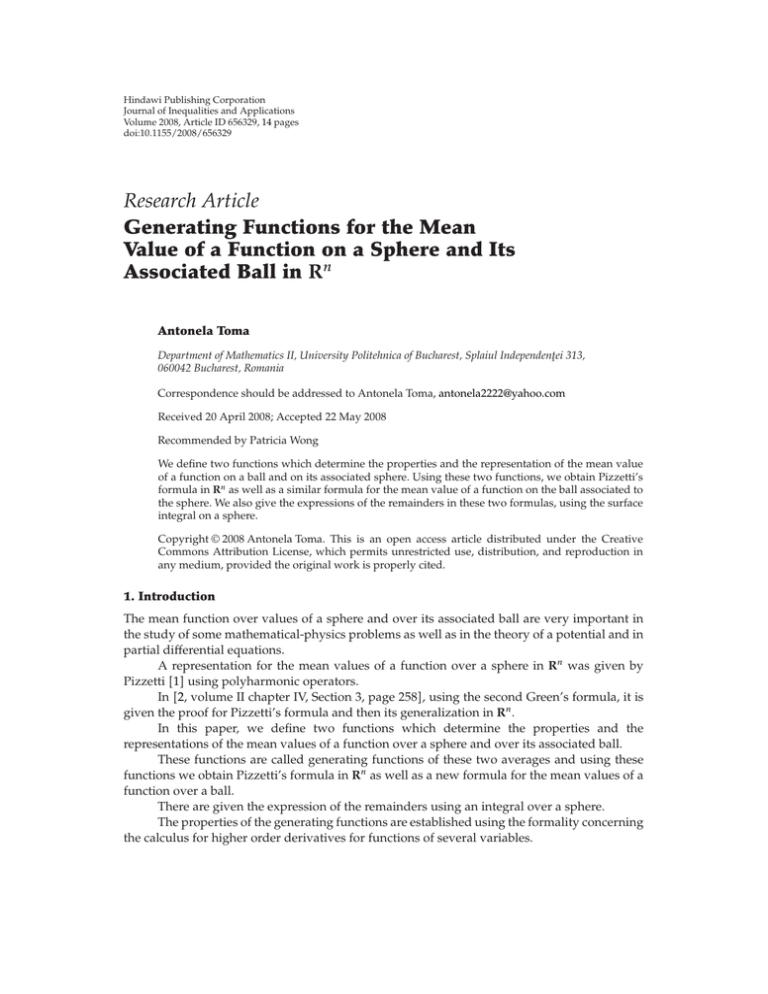
Hindawi Publishing Corporation
Journal of Inequalities and Applications
Volume 2008, Article ID 656329, 14 pages
doi:10.1155/2008/656329
Research Article
Generating Functions for the Mean
Value of a Function on a Sphere and Its
Associated Ball in Rn
Antonela Toma
Department of Mathematics II, University Politehnica of Bucharest, Splaiul Independenţei 313,
060042 Bucharest, Romania
Correspondence should be addressed to Antonela Toma, antonela2222@yahoo.com
Received 20 April 2008; Accepted 22 May 2008
Recommended by Patricia Wong
We define two functions which determine the properties and the representation of the mean value
of a function on a ball and on its associated sphere. Using these two functions, we obtain Pizzetti’s
formula in Rn as well as a similar formula for the mean value of a function on the ball associated to
the sphere. We also give the expressions of the remainders in these two formulas, using the surface
integral on a sphere.
Copyright q 2008 Antonela Toma. This is an open access article distributed under the Creative
Commons Attribution License, which permits unrestricted use, distribution, and reproduction in
any medium, provided the original work is properly cited.
1. Introduction
The mean function over values of a sphere and over its associated ball are very important in
the study of some mathematical-physics problems as well as in the theory of a potential and in
partial differential equations.
A representation for the mean values of a function over a sphere in Rn was given by
Pizzetti 1 using polyharmonic operators.
In 2, volume II chapter IV, Section 3, page 258, using the second Green’s formula, it is
given the proof for Pizzetti’s formula and then its generalization in Rn .
In this paper, we define two functions which determine the properties and the
representations of the mean values of a function over a sphere and over its associated ball.
These functions are called generating functions of these two averages and using these
functions we obtain Pizzetti’s formula in Rn as well as a new formula for the mean values of a
function over a ball.
There are given the expression of the remainders using an integral over a sphere.
The properties of the generating functions are established using the formality concerning
the calculus for higher order derivatives for functions of several variables.
2
Journal of Inequalities and Applications
For this purpose we use two formulas of N. Ya. Sonin and of Dirichlet 3, page 365, 4,
page 671, respectively.
There are defined the corresponding quantities of some scalar quantities using the
differential operators ∇, Δ, Δh .
This fact allows us to prove two new formulas which determine the properties of the
generating functions.
It is very important to mention that in this paper the way of deducting Pizzetti’s formula
is totally different from the way used in 3, page 73 as well as in 5, page 104.
2. General results
Let Ω ⊂ Rn be a bounded set and f : Ω → R, f ∈ C2m1 Ω.
We denote by Sr a {x, x ∈ Rn , |x − a| r} the sphere of radius r, centered in a a1 , a2 , . . . , an , Br a {x, x ∈ Rn , |x − a| ≤ r} the ball of radius r and centered in a which is
associated to Sr a.
We will also denote by R, R max{r |x − a|n } for that Br a ⊂ Ω. We define the
functions
φ : −R, R −→ R, φr f a rx − a dx,
2.1
B 1 a
ψ : −R, R −→ R,
ψr S1 a
f a rx − a dS1 ,
2.2
where dx, dS1 represent the volume element and area element for the unit ball B1 a and for
the unit sphere, respectively.
The mean values Mrs f and Mrb f for f : Ω → R over Sr a ⊂ Ω and over Br a ⊂ Ω,
respectively, are given by the following expressions:
1
fxdS, 0 ≤ r ≤ R,
Mrs f 2.3
Sr a S a
r
Mrb f
1
Br a
B r a
fxdx,
0 ≤ r ≤ R,
2.4
where see 6, page 22 |Sr a| 2π n/2 /Γn/2r n−1 represents the area of the sphere Sr a
and |Br a| 2π n/2 /Γn/2r n /n represents the volume of the ball Br a, Γ being betafunction.
Between the cartesian coordinates x x1 , x2 , . . . , xn and spherical coordinates y ρ, θ1 , . . . , θn−1 centered in a a1 , a2 , . . . , an there are the relations
x1 a1 ρ sin θ1 sin θ2 · · · sin θn−2 sin θn−1 a1 ρh1 ,
x2 a2 ρ sin θ1 sin θ2 · · · sin θn−2 cos θn−1 a1 ρh2 ,
x3 a3 ρ sin θ1 sin θ2 · · · sin θn−3 cos θn−2 a3 ρh3 ,
..
.
xn−2 an−2 ρ sin θ1 sin θ2 cos θ3 an−2 ρhn−2 ,
xn−1 an−1 ρ sin θ1 cos θ2 an−1 ρhn−1 ,
xn an ρ cos θ1 an ρhn ,
2.5
Antonela Toma
3
where
ρ ≥ 0,
θi ∈ 0, π,
i 1, n − 2,
θn−1 ∈ 0, 2π.
2.6
The Jacobian of this punctual transform is
∂x
J ρ, θ1 , . . . , θn−1 ρn−1 sinn−2 θ1 sinn−3 θ2 sinn−4 θ3 · · · sin θn−2 .
∂y
The volume element dy written in spherical coordinates has the expression
dy J ρ, θ1 , . . . , θn−1 dρ dθ1 · · · dθn−1
2.7
2.8
and the area element for Sρ a is
dSρ ρn−1 y ∗ θ1 , . . . , θn−2 dθ1 dθ2 · · · dθn−1 ,
where
∗
J θ1 , . . . , θn−2
2.9
J ρ, θ1 , . . . , θn−1
sinn−2 θ1 sinn−3 θ2 · · · sin2 θn−3 sin θn−2 .
ρn−1
2.10
From 2.8 and 2.9 we have
dy dρ dSρ ρn−1 dρ dS1 θ1 , . . . , θn−1 ,
2.11
where dS1 θ1 , . . . , θn−1 represents the area element of the unit sphere S1 a in spherical
coordinates.
Proposition 2.1. Between the functions φ, ψ : −R, R → R defined in 2.1 and 2.2, there is the
relation
1
φr un−1 ψrudu, |r| ≤ R.
2.12
0
Proof. Using the spherical coordinates and the relations 2.9 and 2.11 we obtain the
following:
ψr f . . . , ai rhi , . . . J ∗ θ1 , . . . , θn−2 dθ1 · · · dθn−1
Δ
φr Δ
1
0
1
2.13
f . . . , ai rhi , . . . dS1 θ1 , . . . , θn−1 ,
Δ
f . . . , ai ruhi , . . . un−1 du dS1 θ1 , . . . , θn−1
un−1
Δ
0
f . . . , ai ruhi , . . . dS1 θ1 , . . . , θn−1
du,
2.14
where Δ 0, π × · · · × 0, π × 0, 2π. From 2.13 we note that
n−2 times
ψru Δ
f . . . , ai ruhi , . . . dS1 θ1 , . . . , θn−1
and taking into account 2.14, the relation 2.12 is proved.
2.15
4
Journal of Inequalities and Applications
Concerning the dependence between the functions φ, ψ and the mean values Mrs f,
of a function f over a sphere and over the associated ball, respectively, we can state the
following.
Mrb f
Proposition 2.2. Between the functions φ, ψ defined by 2.1 and 2.2, respectively, and the mean
f
values Mr f, Mrb f defined by 2.3 and 2.4, there are the following relations:
rn
nΓn/2
φr φr,
Mrb f Br a
2π n/2
0 ≤ r ≤ R,
2.16
nΓn/2
r n−1
ψr ψr,
Mrs f Sr a
2π n/2
0 ≤ r ≤ R.
2.17
Proof. For 0 ≤ r ≤ R, from 2.14 makingthe substitution ur ρ and taking into account 2.4
we obtain
1 r n−1
φr n ρ
f . . . , ai ρhi , . . . dS1 θ1 , . . . , θn−1 dρ
r 0
Δ
2.18
1
2π n/2
b
n
fxdx M f
r Br a
nΓn/2 r
and so, 2.16 is proved.
Using the spherical coordinates, we have
1
Mrs f fxdx
Sr a S x r
0
1
f . . . , ai rhi , . . . dSr θ1 , . . . , θn−1
Sr a Δ
r n−1
f . . . , ai rhi , . . . dS1 θ1 , . . . , θn−1 .
Sr a Δ
2.19
Taking into account 2.13 we have
Γn/2
r n−1
ψr ψr
Mrs f Sr a
2π n/2
2.20
which is 2.17.
The relations 2.16 and 2.17 show that for 0 ≤ r ≤ R, the functions φ, ψ : −R, R → R,
determine the properties of the mean values Mrb f and Mrs f and permit the calculus of these
two quantities.
These relations justify the introduction of the following.
Definition 2.3. The functions φ, ψ : −R, R → R defined by 2.1 and 2.2 are called generating
functions for the mean values Mrb f and Mrs f of a function f : Ω → R over the ball Br a ⊂ Ω
and over the sphere Sr a ⊂ Ω, respectively. Particularly, if f ≥ 0 on Ω ⊂ Rn , then this function
can be considered as the mass density on Sr a and on Br a, respectively.
Antonela Toma
5
Consequently, taking into account 2.3 and 2.17, the total mass msr of the sphere Sr a
is given by the expression
msr Sr a
fxdS Sr aMrs f r n−1 ψr,
0 ≤ r ≤ R.
2.21
In this case, Mrs f represents the mean value of the mass density on Sr a. Similarly, from
2.4 and 2.16 we have the following expression for the total mass on Br a:
mbr B r a
fxdx Br aMrb f r n φr,
0 ≤ r ≤ R.
2.22
The expressions 2.21 and 2.22 prove that the generating functions φ and ψ, when
f ≥ 0 and 0 ≤ r ≤ R, have a mechanical meaning, allowing the calculus of the mass for Sr a
and for Br a with the density ρx fx, x ∈ Ω ⊂ Rn .
Next, for the study of the properties of the generating functions ψ and φ, we will use M.
Ya. Sonin Formula.
Let mi ∈ R, i 1, n be real numbers and k ∈ N0 . Then see 3, page 365, 4, page 671
we have Sonin formula
S
B1 0
π
2k
m1 x1 · · · mn xn dx1 · · · dxn
n−1/2
k
Γk 1/2 2
m1 · · · mrn .
Γn/2 k 1
2.23
Denoting m m1 , m2 , . . . , mn ∈ Rn and “ ” the scalar product, 2.23 becomes
S B1 0
m, x
2k π n−1/2
Γk 1/2
m, m
k .
Γn/2 k 1
2.24
We mention that this result can be justified see 3, page 365 on the basis of Dirichlet
formula
D B 1 0
x12u1
· · · xn2un dx1
Γ μ1 1/2 · · · Γ μn 1/2
,
· · · dxn Γn/2 k 1
2.25
where μi ∈ N0 , i 1, n and k μ1 · · · μn .
Using μ μ1 · · · μn ∈ Nn0 , where |μ| μ1 · · · μn k, Dirichlet formula becomes
Γ μ1 1/2 · · · Γ μn 1/2
.
x dx D Γn/2 k 1
B1 0
2μ
2.26
Making the substitutions ui xi − ai , i 1, n and using Ju1 , . . . , um ∂x/∂u 1 the
6
Journal of Inequalities and Applications
Jacobian of the transform, we have
2k
m, x − a
dx S Γk 1/2
m, m
k ,
Γn/2 k 1
2.27
Γ μ1 1/2 · · · Γ μn 1/2
x − a dx x dx ,
D Γn/2 k 1
B 1 a
B1 0
2.28
B 1 a
B 1 0
m, x
2k dx π n−1/2
2μ
2μ
where B1 a represents the unit ball centered in a ∈ Rn .
Let us consider the integrals
m, x − a
2k dS1 ,
D∗ S∗ S1 a
S1 a
x − a2μ dS1 ,
2.29
where S1 a is the unit sphere, centered in a ∈ Rn .
Proposition 2.4. Between the pairs of integrals S∗ , S and D∗ , D, there are the following relations:
Γk 1/2
m, m
k ,
Γk n/2
2.30
Γ μ1 1/2 · · · Γ μn 1/2
.
D 2k nD 2
Γk n/2
2.31
S∗ 2k nS 2π n−1/2
∗
Proof. Using the spherical coordinates 2.5, we have
x − a h h1 , h2 , . . . , hn .
2.32
Taking into account 2.11, Sonin’s integral 2.27 becomes
m, x − a
2k dx
S
B 1 a
1
0
Δ
m, ρh
2k ρn−1 dρ dS1 θ1 , . . . , θn−1
1
2k n
1
2k n
m, h
dS1 θ1 , . . . , θn−1
2.33
2k
Δ
S1 a
m, x − a
2k dS1 ,
where Δ 0, π × · · · × 0, π × 0, 2π. We obtain
n−2
∗
S S1 a
m, x − a
2k dS1
2k nS
2k n
2
Γk 1/2
π n−1/2 m, m
k
Γn/2 k 1
Γk 1/2 n−1/2
m, m
k .
π
Γn/2 k
2.34
Antonela Toma
7
Using the same procedure, Dirichlet’s integral 2.28 becomes
D
B 1 a
1
Δ
0
x − a2μ dx
m, ρh
2μ ρn−1 dρ dS1 θ1 , . . . , θn−1
1
2k n
1
2k n
2μ
Δ
h dS1 θ1 , . . . , θn−1
2.35
S1 a
x − a2μ dS1 .
Hence
∗
D S1 a
x − a2μ dS1
2k nD
Γ μ1 1/2 · · · Γ μn 1/2
2k n
Γk n/2 1
Γ μ1 1/2 · · · Γ μn 1/2
.
2
Γn/2 k
2.36
So the proposition is proved.
Next, using the formulas concerning the calculus of the higher order differential for
functions of several variables, we will define the correspondings for some scalar quantities
which appear in the expressions of S and S∗ , respectively 2.27 and 2.29.
The corresponding scalar quantities are defined using some differential operators, this
fact leads us to new expressions similar to 2.24 and 2.30.
On the basis of these formulas, we will establish the properties of the generating
functions ψ and φ and of the mean values Mrs f and Mrb f.
Let f ∈ Cp Ω with B1 a ⊂ Ω and 2k ≤ p. We will define the following correspondings:
1
m m1 , . . . , mn −→ ∇fa ∂
∂
fa,
,...,
∂x1
∂xn
2.37
where ∇ ∂/∂x1 , . . . , ∂/∂xn represents the operator “nabla”;
2
|m|2 m, m
−→ ∇, ∇
fa Δfa,
2.38
where | · | represents the norm of a vector and Δ ∇, ∇
∂2 /∂x12 · · · ∂2 /∂xn2 the
Laplace operator in Rn ;
8
Journal of Inequalities and Applications
3
|m|2k m, m
k −→ ∇, ∇
k fa Δk fa,
2.39
2
2
2
2 k
where Δk Δ·Δ
· · · Δ
∂ /∂x1 · · · ∂ /∂xn represents the polyharmonic
k
operator of order k;
4
m, x − a
−→ ∇, x − a
fa ∂ ∂ x1 − a1 · · · xn − an fa
∂x1
∂xn
dfa,
2.40
where d ∂/∂x1 x1 − a1 · · · ∂/∂xn xn − an represents the differential operator;
5
m, x − a
2k −→ ∇, x − a
2k fa d2n fa,
2.41
where d2k ∂/∂x1 x1 − a1 · · · ∂/∂xn xn − an 2k represents the differential
operator of order 2k.
Using these correspondences and taking into account 2.23, 2.27, 2.29, and 2.30,
we obtain
Γk 1/2
Δk fa,
d2k fadx π n−1/2
2.42
Γn/2 k 1
B 1 a
S1 a
d2k fadS1 2π n−1/2
Γk 1/2 k
Δ fa.
Γn/2 k
2.43
We note that the expressions 2.42 and 2.43 represent the correspondings for 2.27
and 2.30. We will prove the availability of these relations.
Proposition 2.5. For f ∈ Cp Ω with B1 a ⊂ Ω and 2k ≤ p the relations 2.42 and 2.43 held.
Proof. We have
B1 a
2k
∂ ∂ fadx1 · · · dxn
x1 − a1 · · · xn − an
∂xn
B1 a ∂x1
2 μ1
2 μn
∂
2k!
∂
·
·
·
fa
·
x − a2μ dx.
2
2
2μ
!
·
·
·
2μ
!
∂x
∂x
1
n
B
a
n
1
2μ1 ···2μn 2k
1
d2k fadx 2.44
√
On the basis of 2k! 2k k!2k − 1!! 22k k!Γk 1/2/ π, we obtain
2k!
π n−1/2 Γk 1/2
k!
.
2μ1 ! · · · 2μn ! μ1 ! · · · μn ! Γ μ1 1/2 · · · Γ μn 1/2
2.45
Antonela Toma
9
Taking into account 2.45 and Dirichlet Formulas 2.43, the expression 2.44 becomes
d fadx π
2k
B1 a
n−1/2
2 μ1
2 μn
∂
k!
∂
···
fa,
2
μ
!
·
·
·
μ
!
∂x1
∂xn2
1
n
n k
Γk 1/2
Γn/2 k 1 μ μ ···μ
1
2
2.46
so that
d fadx π
2k
B1 a
n−1/2
2
∂
Γk 1/2
∂2 k
··· 2
fa
Γn/2 k 1 ∂x12
∂xn
2.47
Γk 1/2
Δk fa.
π n−1/2
Γn/2 k 1
Using the same method, we obtain
S1 a
d2k fadx
2k
∂ ∂ fadS1
x1 − a1 · · · xn − an
∂xn
S1 a ∂x1
2 μ1
2 μn
∂
2k!
∂
···
fa ·
x − a2μ dS1 .
2
∂xn2
S1 a
2μ1 ···2μn 2k 2μ1 ! · · · 2μn ! ∂x1
2.48
On the basis of 2.45 and 2.31, we have
S1 a
d2k fadS1
2π n−1/2
2 μ1
2 μn
∂
k!
∂
·
·
·
fa
2
2
μ
!
·
·
·
μ
!
∂x
∂x
1
n
n
1
n k
Γk 1/2 Γn/2 k μ ···μ
1
Γk 1/2 ∂2
∂2
2π n−1/2
·
·
·
Γn/2 k ∂x12
∂xn2
2π n−1/2
k
fa
Γk 1/2 k
Δ fa
Γn/2 k
and so the proposition is proved.
For the generating functions φ and ψ we can state the following.
2.49
10
Journal of Inequalities and Applications
Proposition 2.6. Let Ω ∈ Rn be a bounded set and f : Ω → R, f ∈ C2m1 Ω. Then the functions
φ, ψ : −R, R → R defined by 2.1 and 2.2, where R max |x − a| such that Br a ⊂ Ω, have the
following properties:
1 φ, ψ are even functions and φ, ψ ∈ C2m1 −R, R,
2 φk 0 ψ k 0 0 for k odd, k ≤ 2m 1,
3 ψ 2k 0 S1 a d2k adS1 2π n−1/2 Γk 1/2/Γn/2 kΔk fa, k ≤ m,
4 φ2k 0 1/n 2kψ 2k 0 π n−1/2 Γk 1/2/Γn/2 k 1Δk fa, k ≤ m,
1
5 φp r 0 unp−1 ψ p rudu, p ≤ 2m 1,
6 ψ p r S1 a dp fa rx − adS1 , p ≤ 2m 1,
2k k
7 ψr 2π n/2 m
k
0 1/k!Γn/2 kr/2 Δ fa R2m1 r,
where
R2m1 r ψ 2m1 θr 2m1
r 2m1
r
2m 1!
2m 1!
8 φr π n/2
m
k
0
S1 a
d2m1 f a θrx − a dS1 ,
0 < θ < 1, 2.50
1/k!Γn/2 k 1r/22k Δk fa R∗2m1 r,
where
R∗2m1 r r 2m1
φ2m1 θr 2m1
r
2m 1!
2m 1!
1
0
un2m d2m1 f aθrux − a du dS1 ,
S1 a
0 < θ < 1.
2.51
Proof. Using the spherical coordinates given by 2.5 and denoting h h1 , . . . , hn , the
expression for ψ given by 2.2 becomes
ψr S1 a
Δ
∗
f a rx − a dS1
J θ1 , . . . , θn−2
2π
∗
2.52
f r, θ1 , . . . , θn−1 dθn−1 dθ1 · · · dθn−2 ,
0
where Δ 0, π × · · · × 0, π, f ∗ r, θ1 , . . . , θn−1 fa rh and J ∗ θ1 , . . . , θn−2 is given by the
n−2
formulas 2.10.
Since f ∈ C2m1 Ω, using the differentiation rule for integrals depending on a
parameter, it results in ψ ∈ C2m1 −R, R.
In order to prove that ψ is an even function we will change the variables θ1 , . . . , θn−1 →
u1 , . . . , un−1 by the relations
in the expression 2.52.
θi π − ui ,
i 1, n − 2,
θn−1 π un−1 ,
ui ∈ 0, π,
i 1, n − 2,
un−1 ∈ −π, π
2.53
Antonela Toma
11
The Jacobian of this transform is defined by
J1 u1 , . . . , un−1
∂ θ1 , . . . , θn−1
−1n−2
∂ u1 , . . . , un−1
2.54
Having this change of variables, 2.52 becomes
ψr J u1 , . . . , un−2
∗
Δ
π
−π
f
∗
− r, u1 , . . . , un−1 dun−1 du1 · · · dun−2 .
2.55
Since f ∗ −r, u1 , . . . , un−1 is periodical, with the period 2π with respect to the variable un−1 , the
expression 2.55 becomes
ψr Δ
J ∗ u1 , . . . , un−2
2π
f ∗ − r, u1 , . . . , un−1 dun−1 du1 · · · dun−2 .
2.56
0
Makingthe comparison between the expression from above and 2.52 we have ψr ψ−r so ψ is an even function.
Consequently, ψ 2k is an even function and ψ 2k1 is odd, it means that ψ 2k1 0 0.
From 2.12 we have φ is even, φ ∈ C2m1 −R, R, φ2k is even and φ2k1 is odd, so
φ2k1 0 0.
So we proved the properties 1 and 2.
n
n
Remark 2.7. In the case of f : Rn → R, f ∈ DRn where DR
is L. Schwartz space, f ∈ CR and having a compact support, then ψ : R → R, ψr S1 a fa rx − adS1 , ψr ∈ CR
with compact support.
If f ∈ DRn , we can state that the formulas
ψr S1 a
f a rx − a dS1 ,
2.57
r ∈ R, define an integral transform which associates f ∈ DRn to the even function ψ ∈ DR.
According to 7, page 61, this integral transform is denoted by Tpn named polare
transform. Thus we write ψ Tpn f. From 2.2 applying the differentiation rule for composite
functions and denoting y a rx − a, we obtain
ψ
p
∂p f a rx − a dS1
p
S1 a ∂r
∂ ∂yi p
fydS1
S1 a ∂yi ∂r
p
∂ ∂ fydS1
x1 − a1 · · · xn − an
∂yn
S1 a ∂y1
dp f a rx − a dS1 .
r S1 a
2.58
12
Journal of Inequalities and Applications
For p 2k ≤ 2m and r 0 we have
ψ 2k 0 S1 a
∂ ∂ x1 − a1 · · · xn − an
∂x1
∂xn
2k
fadS1 S1 a
Taking into account 2.43, we have
Γk 1/2 k
2k
Δ fa.
d2k fadS1 2π n−1/2
ψ 0 Γn/2
k
S1 a
d2k fadS1 .
2.59
2.60
On the other hand, from 2.12 and 2.60 we obtain
φp r 1
unp−1 ψ p rudu,
|r| ≤ R, p ≤ 2m 1,
0
1
ψ 2k 0
n 2k
φ2k 0 2.61
2π n−1/2 Γk 1/2 k
Δ fa
n 2k Γn/2 k
π n−1/2
Γk 1/2
Δk fa.
Γn/2 k 1
The formulas 2.60 and 2.61 justify the properties 3, 4, 5, 6 from the proposition.
In order to obtain the formula 7 we will apply Mac-Laurin formulas. Thus ψ being
even and ψ ∈ C2m1 −R, R, on the basis of 2.58, we can write
ψr m
ψ 2k 0
0
2k!
r 2k R2m1 r,
2.62
where
r 2m1
ψ 2m1 θr 2m1
R2m1 r r
2m 1!
2m 1!
S1 a
d2m1 f a θrx − a dS1 ,
0 < θ < 1. 2.63
Since 2k! 22k k!Γk 1/2π −1/2 and taking into account 2.60, from 2.62 we obtain 7.
Using the same method, we obtain 8 taking into account the results from 4, 5, and
6. So, Proposition 2.6 is proved.
In particular, if f ∈ C−R, R and f is analytic, then the remainders R2m1 t → 0,
→ 0 for m → ∞.
We obtain the following Mac-Laurin Series for ψ, φ : −R, R → R:
R∗2m1 r
ψr 2π n/2
φr π n/2
2k
r
1
Δk fa,
k!Γn/2
k
2
k
0
2k
r
1
Δk fa,
k!Γn/2
k
1
2
k
0
|r| ≤ R,
|r| ≤ R,
2.64
2.65
Antonela Toma
13
The results established in Proposition 2.6 permit to give the corresponding representations for the mean values Mrs f and Mrb f defined in 2.3 and 2.4, by using 2.16 and
2.17.
Thus, for 0 ≤ r ≤ R, taking into account 8, 2.16, and 2.64 we can write
1
b
Mr f fxdx
Br a B a
r
2k
r
1
n
n m
Γ
Δk fa
2
2 k
0 k!Γn/2 k 1 2
2m1 1 r
n
n
Γ
un2m d2m1 f a θrux − a du dS1 , 0 < θ < 1,
n/2
2 2m 1! 0 S1 a
2π
2k
r
1
n
n
Mrb f Γ
Δk fa.
2
2 k
0 k!Γn/2 k 1 2
2.66
Similarly, from 7, 2.62, and 2.17 we have
1
Mrs f fxdS
Sr a S a
r
2k
n m
r
1
Γ
Δk fa
2 k
0 k!Γn/2 k 2
r 2m1
Γn/2
·
d2m1 f a θrx − a dS1 ,
n/2
2m 1! S1 a
2π
2k
r
1
n
Δk fa.
Mrs f Γ
2 k
0 k!Γn/2 k 2
2.67
0 < θ < 1,
We remark that the expression of the remainder for Mrs f given in 2.67
Γn/2 r 2m1
∗∗
R2m1 r d2m1 f a θrx − a dS1 , 0 < θ < 1
n/2
2m 1! S1 a
2π
2.68
2.69
may have other forms as in 2, volume II, chapter IV, Section 3, page 261 and 8.
√
For n 3, since Γ3/2 k 2k 1!/22k1 k! π, from 2.68, we obtain Pizzetti’s
Formula 1:
r 2k
Mrs f 2.70
Δk fa.
2k 1!
k
0
Similarly, since
3
3
3
2k 32k 1! √
k1 k Γ
k Γ
π,
2
2
2
22k2 k!
we have
r 2k
Mrb f 3
Δk fa.
2k
1!2k
3
k
0
2.71
2.72
This last formula constitutes the similarity of Pizzetti’s formula for the mean value
Mrb f over the ball Br a ⊂ R3 .
14
Journal of Inequalities and Applications
References
1 P. Pizzetti, “Sulla media dei valori che una funzione dei punti dello spazio assume alla superficie di
una sfera,” Rendiconti Lincei (5), vol. 18, pp. 309–316, 1909.
2 R. Courant and D. Hilbert, Methoden der Mathematischen Physik, Springer, Berlin, Germany, 1937.
3 G. M. Fichtenholz, Differential-und Integralrechnung. III, vol. 63 of Hochschulbücher für Mathematik, VEB
Deutscher Verlag der Wissenschaften, Berlin, Germany, 1977.
4 I. S. Gradstein and I. M. Ryshik, Tables of Series, Products and Integrals. Vol. 1, 2, Harri Deutsch, Thun,
Switzerland, 1981.
5 G. E. Shilov, Generalized Functions and Partial Differential Equations, vol. 7 of Mathematics and Its
Applications, Gordon and Breach, New York, NY, USA, 1968.
6 S. G. Mihlin, Ecuaţii liniare cu derivate parţiale, Editura Ştiinţifică şi Enciclopedică, Bucureşti, Romania,
1983.
7 W. W. Kecs, Teoria distribiţiilor şi aplicaţii, Editura Academiei Române, Bucureşti, Romania, 2003.
8 M. N. Olevskiı̆, “An explicit expression for the remainder in the Pizetti formula,” Functional Analysis
and Its Applications, vol. 23, no. 4, pp. 331–333, 1989.
